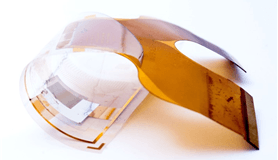A Really Flexible X-ray Sensor

The Imec and Holst Centre has presented a large-area, fully organic photodetector array fabricated on a flexible substrate. The spectral sensitivity of the sensor array makes it suitable for x-ray imaging applications.
The very high absorption coefficient of organic semiconductors allow extremely thin active layers (10 to 50 nm) to be used, and the low processing temperature allows these layers to be deposited on foils. As a result, organic sensors can be more robust and lighter than their conventional counterparts, and conformal coating of substrates with any desired shape is possible. A wide range of available organic molecules also allows the properties of the active layer to be tailored to applications requiring specific spectral sensitivity ranges.
The new sensor is sensitive in the wavelength range of 500 to 600 nm, making it compatible with typical scintillation devices and suitable for x-ray imaging applications. It was fabricated by thermally evaporating an ultrathin (submicron) photosensitive layer of small organic molecules (SubPc/C60) on top of organic readout circuitry. A semi-transparent top contact enables front illumination.
The readout substrate was fabricated on six-inch foil-laminated wafers. It consists of pentacene-based thin-film transistors (TFTs) in 32x32 pixel arrays at two different pitches (1 mm and 200 µm). The photodetector array is encapsulated to prevent degradation of the organic semiconductors due to air exposure. The sensor array has been characterized using a calibrated green LED as a light source, yielding a linearly increasing photocurrent from a base sensitivity level of 3 µW/cm². Dark current density is under 10-6 A/cm² at a bias voltage of -2 V.
